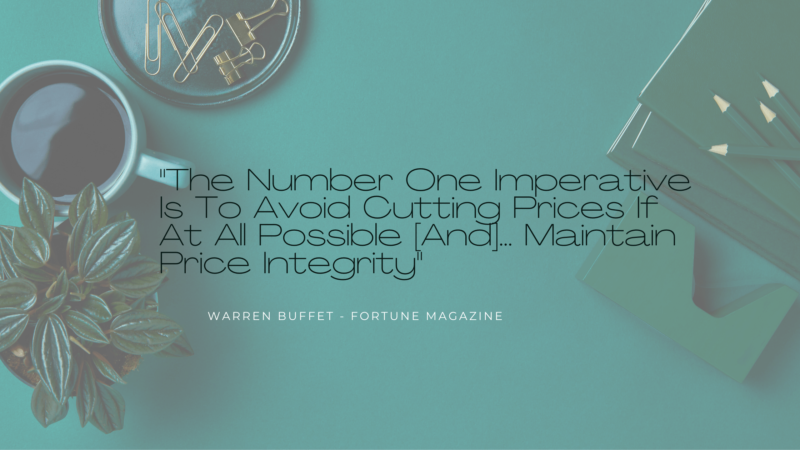
The Experts’ Top 5 Reasons Why Cutting Prices Is A Bad Idea
The Experts’ top 5 reasons why cutting prices is a bad idea
Bravo to Geoff Colvin , Fortune Author on an engaging article: Why slashing prices is usually a terrible idea! from where this except hails from, It spurred me onto doing a top 5 roundup of 5 great reasons as to why lowering prices, especially during an economic downturn seems to be a negative for small businesses.
“Warren Buffett is an aggressive pricer. He mostly leaves the managers of Berkshire Hathaway’s portfolio companies alone, but when it comes to setting prices at companies including Candies and the Buffalo News, he has often liked to be involved.
“The manager has just one business,” he once explained to Fortune. “His equation tells him that if he prices a little too low, it’s not that serious. But if he prices too high, he sees himself screwing up the only thing in his life.” Such excessive risk aversion leaves money on the table, Buffett figures, so he often pushes for higher prices. More often than not, he’s right.
Even in a historic downturn, Buffett’s instinct is worth keeping in mind. Many managers underestimate the power of pricing, and the unanimous advice from pricing experts in this troubled economy is to price with courage and creativity. In businesses where demand has plunged, slashing prices may be a terrible idea—and it may not be necessary at all.
In a few special cases—think hand sanitizer—the pandemic has turbocharged demand. Yet even here, managers need courage. It’s the courage to abstain from multiplying prices by five or 10 or 20, or whatever the market will bear. The winners will be those who think long-term, difficult as that is in a crisis.
For the vast majority of businesses—those facing strapped customers and shrunken demand—the No. 1 imperative is to avoid cutting prices if at all possible, what experts in the field call “maintaining price integrity.”
Read The rest of Colvin’s article HERE

1. When you cut your price, you can immediately decrease your reputation as a business with high-quality products and services. This means that your customers can think that you have lowered your prices because of the low quality that they will get from you [even if nothing has changed but the price] – Entrepreneurship In A Box
 2. The Relationship Between Price and the Perceived Value of a Product: Setting a certain price for your product isn’t just about making it affordable for customers. It also plays a crucial psychological role in the value of your product by consumers. The way you price your services or products is a direct communication to customers, telling them how much your products and your brand are worth. A perceived value for these is instantly created in the minds of consumers. If you decide to price your product or service lower than the competition, then you are sending a different kind of message depending on who is listening. To a value shopper, you are saying that your product or service is a bargain when compared with the competition. To a high-end shopper who is looking for a product or service that will make them feel like they are part of an exclusive club, you are saying that your product or service is of inferior quality. The fact that almost everyone can afford what you are selling makes it cheap (and trivial) to them, which scares them away from your shop. On the other hand, such a customer is likely to rush to buy your product or pay for your service if you price it high, simply because the message they are getting is that you offer an exclusive luxury good. – Small Business Chronicle
2. The Relationship Between Price and the Perceived Value of a Product: Setting a certain price for your product isn’t just about making it affordable for customers. It also plays a crucial psychological role in the value of your product by consumers. The way you price your services or products is a direct communication to customers, telling them how much your products and your brand are worth. A perceived value for these is instantly created in the minds of consumers. If you decide to price your product or service lower than the competition, then you are sending a different kind of message depending on who is listening. To a value shopper, you are saying that your product or service is a bargain when compared with the competition. To a high-end shopper who is looking for a product or service that will make them feel like they are part of an exclusive club, you are saying that your product or service is of inferior quality. The fact that almost everyone can afford what you are selling makes it cheap (and trivial) to them, which scares them away from your shop. On the other hand, such a customer is likely to rush to buy your product or pay for your service if you price it high, simply because the message they are getting is that you offer an exclusive luxury good. – Small Business Chronicle

3. Price wars typically start when there is heavy competition and/or several comparable products available [think cloth face masks in the current pandemic]. Discounting has its place, but for small businesses, in particular, it can be an illusory competitive advantage. It doesn’t necessarily set the stage for a profitable pricing strategy. With companies like Amazon and Wal-Mart leading the price-cut charge, it’s tempting for small business owners to follow suit. After all, consumers and businesses alike are addicted to discounts. And it’s easy to simply reduce your product selling price [but in the long run that will not be advantageous or allow you to compete long term] -Small Business Rainmaker
Further Disadvantages of a Price Reduction Strategy
- Customers come to expect it, especially if it’s a straightforward price decrease with no other components.
- It creates a disproportionate decrease in profits
- It’s more work for the business and it takes longer to recover from mistakes, exchanges, and refunds.
- It can lead to long-term loss of customers and a decline in sales.
- You start to attract the wrong kind of customer—the price shopper.
- It can create a lower perceived value (people think your product is simply worthless)
- It damages your brand. Customers who paid full price could resent your price cuts. Prospects perceive your product as less valuable.
- It’s not a band-aid for systemic problems. For instance, it won’t fix lousy customer service.
- Costs might go up. For instance, if you increase your volume, your miscellaneous variable costs might go up, negating the purpose of the price cut.
- Your competitors might respond with even more price cuts, which can lead to a price war. No one wins.

4. Your small business can gain market share by setting prices lower than the competition, but you may not be able to sustain that practice. If you market yourself as having everyday low prices, you will encounter business problems that you have not anticipated. The constant struggle to make up for lower prices by selling higher volumes can strain your operation. Your competitors can lower their prices to beat yours, and you may find yourself in a battle to see who sells the cheapest and still makes a profit. Once you reach your absolute bottom price, you will lose your competitive edge if your competition can still beat your prices. [think Amazon and Walmart] – Your Business A to Z Central
Reduced Profit Margins: If you cannot get low-enough prices from vendors, (or supplies if you’re a handmade business) you may have to sell products at a price that does not leave you enough profit. You have to constantly monitor the volume of sales of greatly reduced products to see if you are getting your original investment back on those products.
Perception of Poor Quality: Once you establish a reputation for having everyday low prices, you may find that customers suspect the quality of your products. You may find it difficult to introduce higher-priced and higher-quality lines of products, because customers who want higher quality may not believe you can offer exceptional goods.
Inability to Have Sales: Once you advertise everyday low prices, you cannot put products on sale. You claim that you already offer the lowest prices, so offering a discount during a sale would indicate that your prices are higher than they need to be the rest of the time. This can present problems if you want to move items that do not sell well. Though you may be willing to sell products below cost to clear out inventory, your customers may mistakenly think that you have room to lower prices on other items.

5. Lowering Prices Could Anger Past Customers. Lowering the prices of your product or service could anger customers who have already purchased at a higher price. How would you feel if you bought a computer at Best Buy for $600, only to find out the next day that Best Buy lowered the price to $400? You’d probably feel ripped off. Amazon deals with this issue proactively. They issue refunds to all past customers of products when they lower the price, without the customers having to ask. In other words, if you buy a CD for $10 and they change the price to $5, Amazon will pay you $5 without prompting. There are ways to handle the customer relations issue, but it could cost money and take time and energy.
Did you find this blog article on The Experts’ Top 5 Reasons Why Cutting Prices Is A Bad Idea helpful? Drop us a comment and let us know. We’d love to continue the conversation with you below! Follow us on Instagram. Have you checked out the MamaPacifico Girl Gang yet?





